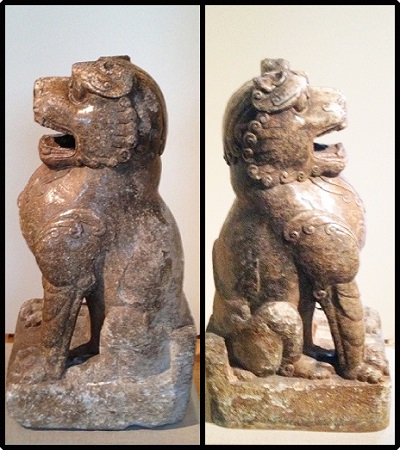
Unknown
Chinese
Pair of Guardian Lions, 386-535, Northern Wei period
stone
25 1/4 × 9 3/4 × 12 5/8 in. each
SBMA, Gift of Mrs. Ina T. Campbell
1946.1.1-2
RESEARCH PAPER
This pair of guardian lions, about two-and-one-half feet high, are in a typical Fo Dog position, sitting on their haunches with mouths wide open, their teeth showing in a ferocious way, large round eyes wide open. The ears are broken on both lions. A very stylized mane ends in round curls, while the tail curls up the back and ends in a straight brush. A round medallion design appears on the chest and in the center of the forehead. Strong incised lines denote wrinkles on forearms and forefeet. There is some evidence that the lions were once painted with a brownish glaze. These lions typify the Six Dynasties sculpture, which was executed in a more animated and vigorous style than in the preceding Han period.
During the Six Dynasties period of governmental and social upheaval, Buddhism took hold. As is often the case in times of trouble, man looks to a higher being for help. The Mahayana concept of Buddhism was more easily acceptable to the ancestor worshipping Chinese. Indian missionaries journeyed to China, and it is the association with Buddha that gives us the Fo Dog or Buddha Dog, as these guardian lions are called.
The Fo Dog owes its name to its placement outside Buddhist temples, usually beside the column that supports the temple entrance. The base of this column is known as the Fo, and the Fo Dog sits adjacent to this column to protect the threshold and guard the entrance to the sacred building.
SYMBOLISM OF THE LION
The lion was an important animal for artistic interpretation in early China. Although not native to the orient, a few lions were probably present, sent as gifts to the emperors by such distant countries as Persia, where the lion was used as a royal tribute. Because few Chinese had actually seen a lion, they were thought of as mythological creatures, and many interpretations of their physical characteristics and spiritual powers appeared.
Lions, chimeras, horses, and other creatures in gigantic statues lined both sides of the spirit path at approaches to the grave mounds of the Han, Six Dynasties, and T'ang periods, as well as approaches to the tombs of the Liang and Southern Sung rulers. These descendants of the great Han lions were intended to scare away evil spirits which might disturb the peace of the dead.
The lion is also closely associated with Buddhism. It is recognized as the emblem of Buddha himself, as he is referred to in sacred texts as “he with the lion’s voice.” Huge statues of lions are generally placed in front of Buddhist temples and palaces. The male represents the Yang principle and is placed facing the east; the female, representing the Yin principle, is placed facing the west. The buildings open to the south, which according to Chinese mythology is in the direction of the vermilion bird of summer, the source of fire and life.
Prepared for the Santa Barbara Museum of Art Docent Council by Mary Lou Sherwin
SBMA CURATORIAL LABELS
This pair of lions originally stood at the entrance to a shrine or tomb. The combination of the stylized treatment of their bodies and the linear details illustrate the vitality of the Northern Wei period.
- Asian Gallery, 2012
